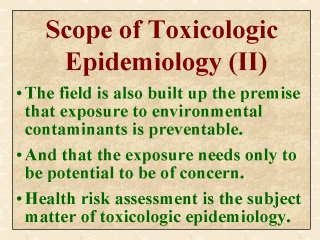| front |1 |2 |3 |4 |5 |6 |7 |8 |9 |10 |11 |12 |13 |14 |15 |16 |17 |18 |19 |20 |21 |review |
 |
The last slide
did not cover two other important elements that are inherent in health risk assessment
(RA). One of these is that environmental contaminants are the main bundle of chemicals
subject to RA, primarily because they are preventable at least in concept, such as through
regulation of their use. The other important element is that the exposure of a community
to the contaminant needs only to be potential to become a public health concern. It is in part due to such a potential risk that the hazards (i.e., adverse health effects) involved need to be demonstrated through one or more toxicity studies, those typically conducted in animals primarily because of ethical reasons. As discussed in Lecture 9, the need for toxicity assessment as the first step in RA is based upon the recognition that a safe dose level is required in order to qualify as well as to assess the exposure at issue. At about the same time when the environmental epidemiology classic edited by Goldsmith (1986) was published, Clayson et al. (1986) also edited a two-volume collection entitled Toxicological Risk Assessment. Although the importance of toxicology in RA was well discussed in this two-volume text, it falls short of bringing out the importance of human exposure assessment, an area more appealing to the epidemiologist (see Lecture 7). Here disguised as toxicologic epidemiology, RA is more a sub-discipline of epidemiology than of toxicology. This is because health risk is basically a community issue and the epidemiologist is typically interested in the occurrence of community disease by time, place, and persons. |